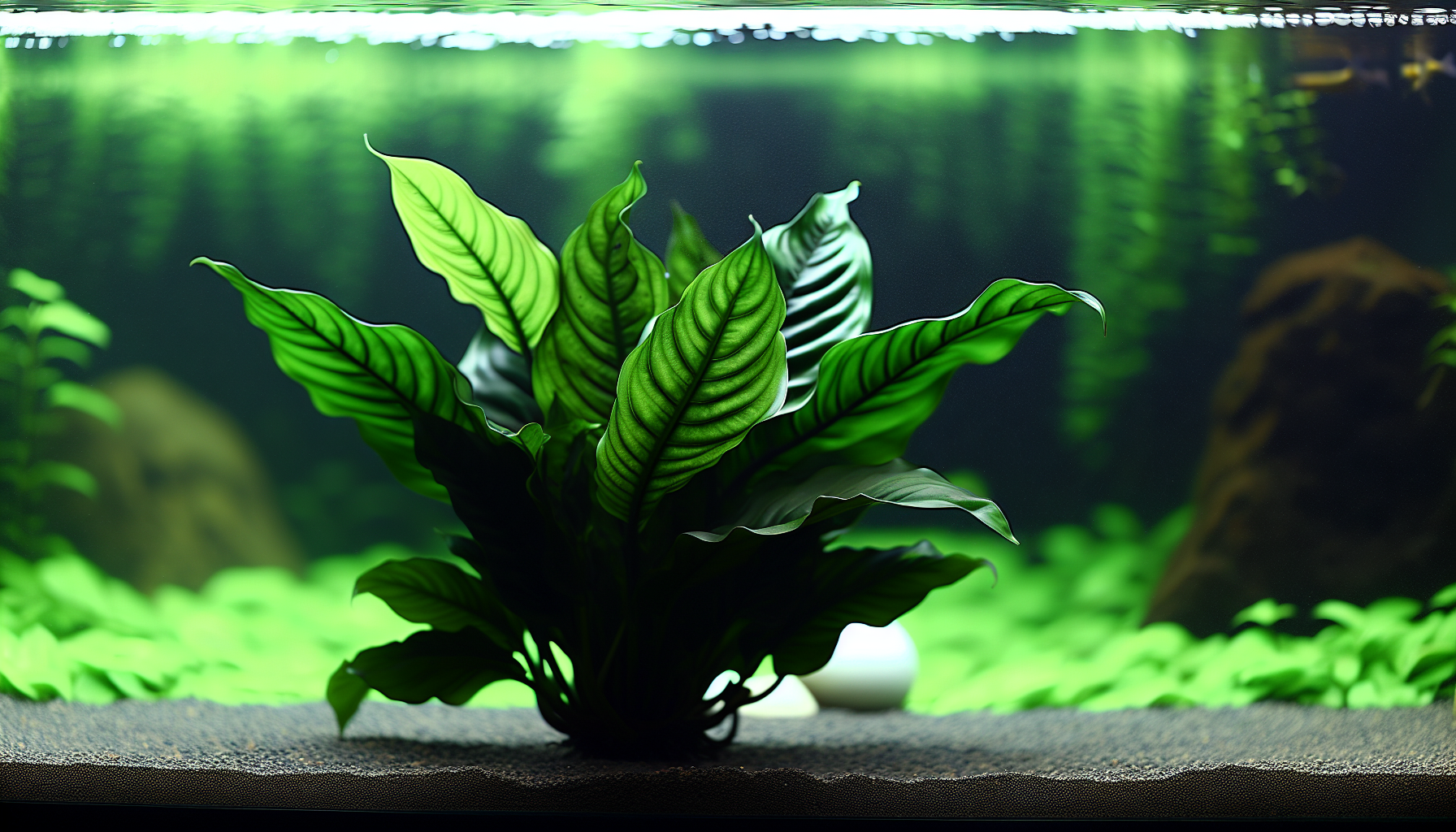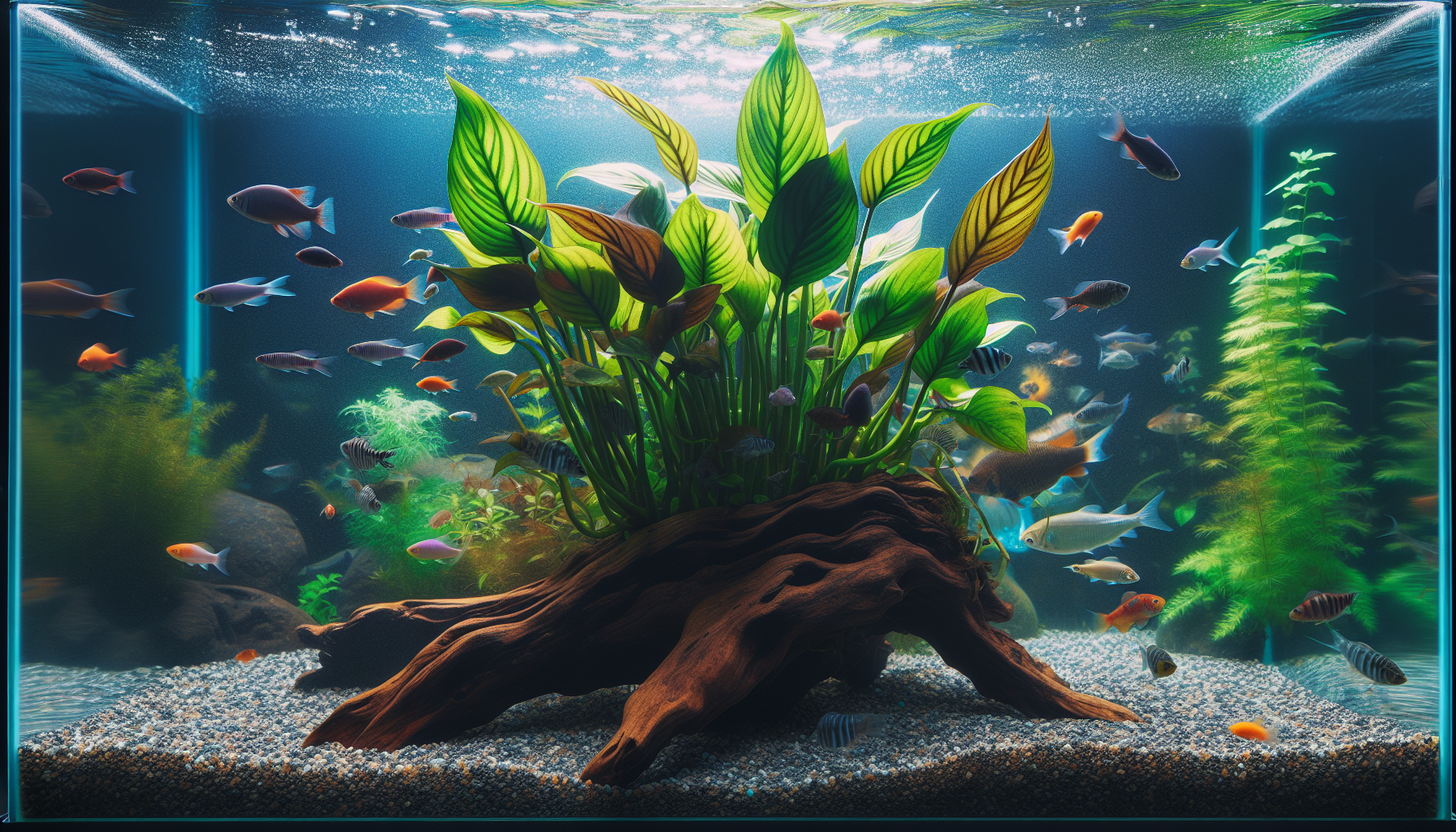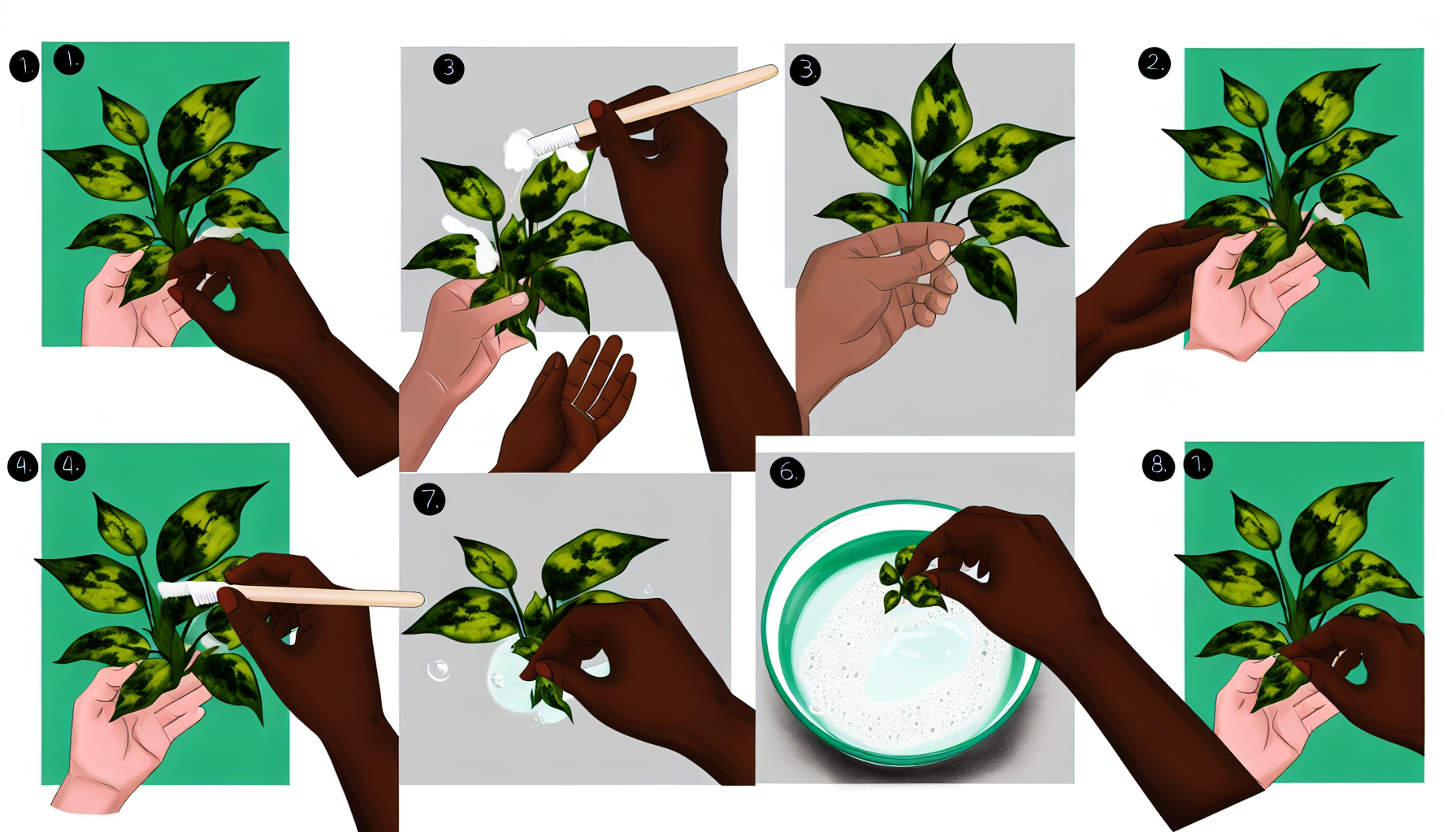Anubias Barteri: Essential Tips for Lush, Healthy Anubias Plants
Need guidance on nurturing anubias barteri? Get the essentials on picking the healthiest plants, ideal positioning, and simple care steps to keep your anubias thriving. Perfect for all aquarists, this article cuts straight to the chase, delivering the know-how for lush anubias barteri growth.
Table of Contents
Key Takeaways
- Anubias Barteri is a resilient midground plant ideal for aquariums; it has broad leaves, is tolerant of various water parameters, requires minimal lighting, and can be planted on hard surfaces for optimal health.
- Proper Anubias plants care includes keeping the rhizome above the substrate, offering moderate lighting to balance growth and algae resistance, and considering additional iron supplementation for more robust foliage.
- Anubias plants propagation involves division of the rhizome, placement of the cuttings on suitable surfaces or substrates, and attention to water conditions; the variety of Anubias species available allows for creative aquascaping and diversification of aquarium environments.
Discovering Anubias Barteri: The Ideal Midground Plant for Aquariums

Hailing from the tropical regions of central and western Africa, Anubias Barteri is a versatile plant that thrives in various anubias aquarium plants environments, including those featuring anubias plants. It is characterized by broad, thick, dark green leaves that provide significant coverage in the aquarium, adding depth and color to your aquatic landscape. The slow growth rate of this anubias plant results in a mature size of about 7.5 inches in height and around 16 inches in spread, making it an ideal midground plant.
The versatility of Anubias Barteri extends beyond its lush appearance. This plant makes a harmonious addition to diverse tank habitats, seamlessly blending with Cherry Shrimp, Nano Fish, or Snails. Its compatibility makes it a cherished choice among aquarists.
Identifying Healthy Anubias Plants Specimens
When selecting Anubias Plants specimens, there are a few key traits to look out for. A healthy Anubias Barteri exhibits a vibrant medium to dark green color in its broad leaves, an indicator of good health and proper care. The robustness of the plant can also be gauged by its sturdy and thick rhizome, which is critical for its survival as it stores necessary nutrients. This hardy nature makes Anubias Barteri an ideal choice for many aquarium enthusiasts.
Avoiding specimens with signs of algae growth or physical damage is equally important. Indicators of poor health or suboptimal maintenance may include cracked or broken leaves, leaves with holes, or any signs of disease. Choosing healthy specimens is the initial stride towards nurturing a thriving Anubias Barteri plant in your aquarium.
Placement Tips for Anubias Barteri

Once you have a healthy Anubias Plants specimen, the next step is to determine its placement in your aquarium. Ideally, Anubias Barteri should be placed in the middle or back of your aquarium display. Due to its mature size and growth habit, it contributes to a well-structured aquascape.
Anubias plants prospers when anchored to a hard surface like a rock or driftwood, allowing exposure for the rhizome and roots, a critical factor for its growth. You can secure the plant to the hardscape using natural crevices on rocks, applying glue to dry roots, and holding the plant in position to ensure a firm attachment. Not only does this enhance the appearance of your aquascape, but it also contributes to the plant’s health and aesthetic appeal by minimizing algae growth on its leaves.
Mastering Anubias Care: Ensuring Your Plants Thrive

Anubias plants are a hardy plant, adaptable to a range of lighting levels, and maintains health across various water parameters. It’s a forgiving species, a perfect choice for both seasoned aquarists and beginners alike. However, while CO2 supplementation is not necessary for Anubias Barteri, it can contribute to more robust growth.
A significant facet of Anubias plants care involves making sure that the rhizome isn’t covered in the substrate, an important step in preventing rot and promoting healthy growth. Especially for newly propagated cuttings, it is vital to keep the rhizome exposed to light to prevent the potential for rot.
Water Parameters for Optimal Growth
Anubias Barteri prefers a water temperature range of 72 to 82 ºF. This range is akin to that of many tropical aquariums, making it compatible with a variety of tank inhabitants. The ideal pH range for Anubias Barteri is 6.5 to 7.5, although it can adapt to a range of 6.0 to 8.0.
These Anubias plants can also thrive in soft to medium-hard water conditions, with a general hardness (GH) of 2-15. Like most aquatic plants, Anubias Barteri benefits from a regular refreshment of tank water. It is recommended to refresh tank water by 20 to 30% 1-2 times a month to maintain a healthy environment for Anubias Barteri.
Lighting Requirements: Finding the Sweet Spot
Despite Anubias Barteri’s ability to adjust to a variety of lighting levels, finding the optimal intensity is key to maintaining its health and vitality. Providing Anubias Barteri with medium to high light levels can encourage denser growth and possible flowering. However, it can also increase the plant’s susceptibility to algae growth on leaves.
To prevent algae infestations, Focus on anubias care, ensure your Anubias plant receives enough light for growth without exceeding the light threshold that weakens the plant. If the plant shows signs of stress from strong lighting, such as yellow spots on leaves, it should be moved to a shadier area or supplemented with floaters to reduce light intensity. The optimal lighting condition for Anubias plant is low to medium light to ensure healthy growth and minimal algae risk.
Substrate and Fertilization Needs
Anubias Barteri can be planted in nutrient-dense substrate or aquarium gravel, both of which support its growth. However, it performs notably better in nutrient-rich substrate. When planting Anubias Barteri, care must be taken to ensure that the rhizome is not buried in the substrate to prevent rot and promote health.
In a well-maintained aquarium, Anubias Barteri generally does not require supplementary fertilization, but it may benefit from extra nutrients in certain conditions. For instance, providing additional iron dosing to Anubias Barteri can promote healthier and more robust growth, a testament to its versatility and adaptability.
Propagating Anubias Barteri: Expand Your Aquatic Garden

Propagation is a great way to expand your aquatic garden, and Anubias Barteri is no exception. This plant is propagated by:
- Carefully cutting the rhizome into two or more pieces
- Ensuring that each new section has at least three or four healthy leaves
- Remembering to avoid damaging the existing roots when cutting the rhizome for propagation.
Once you’ve successfully propagated your Anubias Barteri, it’s vital to care for the new cuttings properly. This involves arranging them in suitable locations and maintaining appropriate water conditions. With the right care, your newly propagated Anubias Barteri will thrive, adding more beauty to your aquarium.
When to Propagate
Knowing when to propagate Anubias Barteri is key to ensuring successful division and continued growth. A mature Anubias Barteri ready for propagation will exhibit a dense cluster of leaves, indicating that the plant is robust and can sustain division.
Other signs that your Anubias Barteri is ready for propagation include:
- The appearance of additional shoots
- A substantial number of roots along the plant’s rhizome
- An overcrowded rhizome, where leaves and roots are densely packed
These signs often indicate that propagating the Anubias Barteri will help manage its size and promote healthier growth.
Techniques for Successful Division
Anubias Care: Dividing your Anubias Barteri requires the correct tools and technique. Use a very sharp blade, such as a scalpel, for separating the rhizome to ensure clean cuts are achieved. This helps prevent damage and potential rot.
Ensure that each section of the rhizome has a few leaves attached to promote successful growth following the division. You can promote new growth and branching by making small, shallow slits or slight nicks on the rhizome using a razor blade.
The best time to divide the plant is when the rhizome has grown long with leaves concentrated at one end. This allows you to distribute the growth more evenly after replanting.
Anubias Care for New Cuttings
Proper care of new Anubias Barteri cuttings is vital for their survival and development. New cuttings should be tied down to pieces of driftwood or placed in a suitable substrate to anchor them while they establish new roots.
Regular dosing of iron in the water column can stimulate the growth of new leaves in Anubias Barteri. Trimming old leaves may also accelerate leaf growth in newly propagated Anubias Barteri.
When transitioning Anubias Barteri from emersed to submersed conditions, it may lose leaves but will eventually grow new ones as it adapts to the underwater environment.
Combating Algae: Keeping Your Anubias Barteri Clean

Anubias Barteri’s broad, slow-growing leaves can sometimes be prone to algae growth. However, with proper care and preventive measures, you can keep your Anubias Barteri clean and healthy. Here are some strategies you can employ to prevent algae growth:
- Optimize lighting conditions
- Ensure adequate water flow
- Avoid overfeeding
- Regularly clean and maintain your aquarium
- Use algae-eating fish or snails as natural cleaners
By following these strategies, you can maintain a clean and healthy Anubias Barteri plant.
But what if algae already appeared on your Anubias Barteri? Don’t worry. There are several cleaning techniques you can use to restore your plant’s health and aesthetics, such as diluted bleach or hydrogen peroxide dips. Let’s explore these strategies in more detail.
Preventative Measures
A combination of strategies is needed to prevent algae growth on Anubias Barteri. Here are some tips:
- Place Anubias Barteri in shaded areas and near currents to help prevent algae growth on its leaves.
- Optimize lighting conditions to suit its low to medium light requirements.
- Control phosphate to nitrate dosing ratios and CO2 levels.
By following these strategies, you can keep your Anubias Barteri healthy and free from algae.
Introducing Ramshorn and smaller varieties of Nerite snails to the aquarium provides biological algae control by cleaning the leaves of Anubias Barteri. Regular water changes also reduce algae by removing detritus from Anubias Barteri leaves. Increasing phosphate dosing in the aquarium can help combat green spot algae on Anubias Barteri.
Cleaning Techniques for Algae-Affected Leaves
If your Anubias Barteri leaves are already affected by algae, there are several cleaning techniques you can use. One method involves using a diluted bleach solution to clean algae from Anubias leaves. Algae can also be removed by dipping the leaves in diluted hydrogen peroxide, followed by air drying before replanting the plant in the aquarium.
Another effective method is gently rubbing the leaves with a toothbrush or using a fingernail to physically remove algae. Algae-infested leaves that are still healthy can be treated with specialized algae treatment products to restore the plant’s appearance. Always remember to rinse the leaves under cold running water to remove any residue after cleaning.
Creative Aquascaping with Anubias Barteri
Anubias Barteri is more than a plant; it’s an avenue for creative expression in your aquascape. It can be attached to aquarium rocks like Texas holey rock and lava rocks, using cyanoacrylate-containing super glue gel, which forms a durable bond. Whether it’s the middle or the back of the tank, a well-placed Anubias Barteri can transform the look of your aquarium plants garden, complementing the aquarium substrate.
Driftwood serves as an excellent mounting surface for Anubias Barteri, which can be secured with fishing line, cotton thread, or zip ties. You can also create a ‘tree’ effect in the aquascape by positioning Anubias Barteri at the ends of vertically placed driftwood, simulating leafy foliage. For a tiered aquascape, Anubias Barteri can be arranged on varied levels of rocks or driftwood, adding depth and perspective to your setup.
Anubias Barteri Varieties: Exploring Other Types
Anubias Barteri is a versatile species, boasting several varieties, each offering distinct characteristics and aesthetics. These varieties include:
- Standard form
- Round leaf
- Broad leaf
- Glabra
- Caladiifolia
Each one offers different leaf shapes and colors, giving you more options to create a unique and diverse aquatic garden with most plants.
In addition to the popular Anubias Barteri, other varieties such as ‘Nana’, ‘Minima’, and ‘Congensis’ provide additional choices for aquarists. Whether you’re looking to add a touch of color, change up the leaf shapes, or vary the sizes of plants in your tank, exploring other Anubias Barteri varieties can open up a world of possibilities.
Anubias Barteri 'Glabra': A Unique Aesthetic
If you’re seeking a unique aesthetic in your aquarium, consider the Anubias barteri var. glabra. This West African species is known for its long, narrow leaves that contribute to its distinct beauty. With a moderate size and a slow growth rate, this variety can be a great addition to any aquarium.
This variety was previously misidentified as Anubias afzelii, which is notably larger. This implies the importance of proper species identification in aquatic horticulture. With its unique leaf shape, the Anubias barteri var. glabra stands out from its counterparts within the species, adding a touch of uniqueness to your aquatic garden.
Anubias Congensis: Broad Leaves and Vertical Growth
Another variety to consider is Anubias congensis, also known as Anubias afzelii. This variety is distinguished by its slender and sharp leaves, providing a different aesthetic from the round leaves of Anubias barteri or Anubias nana. It is native to the tropical regions of Africa and commonly grows along streams, rivers, and marshes, reflecting its adaptability to a variety of wet habitats.
With its unique leaf shape and growth patterns, Anubias congensis offers an interesting visual contrast to other Anubias varieties in your aquarium. By incorporating different varieties like Anubias congensis, you can create a more diverse and visually interesting aquascape that reflects your unique style and vision.
Summary
From its lush green leaves to its versatile adaptability, Anubias Barteri is a jewel in the crown of any aquarium. Whether you’re a seasoned aquarist or just starting your journey, this plant offers beauty, diversity, and resilience that can enhance your aquatic garden. With proper care and placement, Anubias Barteri can thrive in your aquarium, providing a serene environment for your aquatic friends.
As you venture into the world of Anubias Barteri, remember that each plant is unique, and your care approach should reflect that. Don’t be afraid to experiment with different varieties, placements, and propagation techniques. With a little patience and creativity, you can create an aquatic garden that is truly your own, filled with the lush beauty of Anubias Barteri.
We also sell Anubias here at The Shrimp Farm!
Frequently Asked Questions
Anubias barteri can grow to about 9-14 inches in height, making it considerably larger than Anubias barteri var. Nana. It is a hardy and attractive aquarium plant.
Maintain the water temperature between 72°F to 82°F and ensure good water quality through regular changes to help Anubias barteri thrive. Unlike other aquatic plants, it doesn't need a nutrient-rich substrate.
The main difference between Anubias Nana and Barteri is that Anubias Nana is the smaller variant of Anubias Barteri, suitable for smaller tanks and prefers to grow attached to rock or wood to prevent rotting of the rhizome.
No, Anubias should not be planted in the substrate like other plants because it is an epiphyte. Planting it in a way that suffocates the rhizome can cause it to rot and the plant to die.
The ideal water parameters for Anubias Barteri are a temperature range of 72 to 82 ºF, a pH range of 6.5 to 7.5, and a general hardness (GH) of 2-15.



 Shrimp
Shrimp Fish
Fish Crab &
Crab & Plants
Plants Foods
Foods Snails
Snails